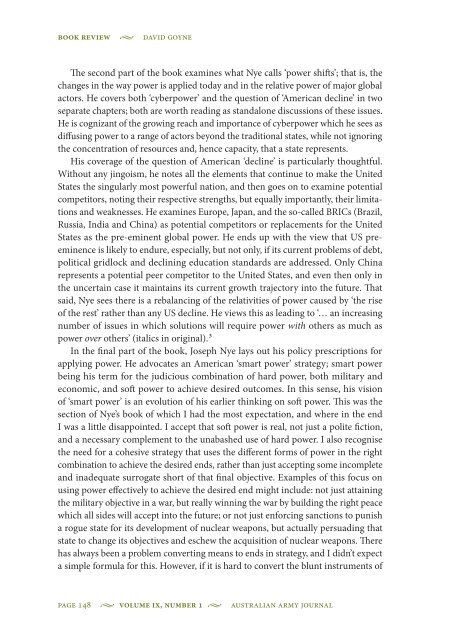The Future of Power by Joseph S Nye Jr - Australian Army
The Future of Power by Joseph S Nye Jr - Australian Army
The Future of Power by Joseph S Nye Jr - Australian Army
You also want an ePaper? Increase the reach of your titles
YUMPU automatically turns print PDFs into web optimized ePapers that Google loves.
Book review • David Goyne<strong>The</strong> second part <strong>of</strong> the book examines what <strong>Nye</strong> calls ‘power shifts’; that is, thechanges in the way power is applied today and in the relative power <strong>of</strong> major globalactors. He covers both ‘cyberpower’ and the question <strong>of</strong> ‘American decline’ in twoseparate chapters; both are worth reading as standalone discussions <strong>of</strong> these issues.He is cognizant <strong>of</strong> the growing reach and importance <strong>of</strong> cyberpower which he sees asdiffusing power to a range <strong>of</strong> actors beyond the traditional states, while not ignoringthe concentration <strong>of</strong> resources and, hence capacity, that a state represents.His coverage <strong>of</strong> the question <strong>of</strong> American ‘decline’ is particularly thoughtful.Without any jingoism, he notes all the elements that continue to make the UnitedStates the singularly most powerful nation, and then goes on to examine potentialcompetitors, noting their respective strengths, but equally importantly, their limitationsand weaknesses. He examines Europe, Japan, and the so-called BRICs (Brazil,Russia, India and China) as potential competitors or replacements for the UnitedStates as the pre-eminent global power. He ends up with the view that US preeminenceis likely to endure, especially, but not only, if its current problems <strong>of</strong> debt,political gridlock and declining education standards are addressed. Only Chinarepresents a potential peer competitor to the United States, and even then only inthe uncertain case it maintains its current growth trajectory into the future. Thatsaid, <strong>Nye</strong> sees there is a rebalancing <strong>of</strong> the relativities <strong>of</strong> power caused <strong>by</strong> ‘the rise<strong>of</strong> the rest’ rather than any US decline. He views this as leading to ‘… an increasingnumber <strong>of</strong> issues in which solutions will require power with others as much aspower over others’ (italics in original). 3In the final part <strong>of</strong> the book, <strong>Joseph</strong> <strong>Nye</strong> lays out his policy prescriptions forapplying power. He advocates an American ‘smart power’ strategy; smart powerbeing his term for the judicious combination <strong>of</strong> hard power, both military andeconomic, and s<strong>of</strong>t power to achieve desired outcomes. In this sense, his vision<strong>of</strong> ‘smart power’ is an evolution <strong>of</strong> his earlier thinking on s<strong>of</strong>t power. This was thesection <strong>of</strong> <strong>Nye</strong>’s book <strong>of</strong> which I had the most expectation, and where in the endI was a little disappointed. I accept that s<strong>of</strong>t power is real, not just a polite fiction,and a necessary complement to the unabashed use <strong>of</strong> hard power. I also recognisethe need for a cohesive strategy that uses the different forms <strong>of</strong> power in the rightcombination to achieve the desired ends, rather than just accepting some incompleteand inadequate surrogate short <strong>of</strong> that final objective. Examples <strong>of</strong> this focus onusing power effectively to achieve the desired end might include: not just attainingthe military objective in a war, but really winning the war <strong>by</strong> building the right peacewhich all sides will accept into the future; or not just enforcing sanctions to punisha rogue state for its development <strong>of</strong> nuclear weapons, but actually persuading thatstate to change its objectives and eschew the acquisition <strong>of</strong> nuclear weapons. <strong>The</strong>rehas always been a problem converting means to ends in strategy, and I didn’t expecta simple formula for this. However, if it is hard to convert the blunt instruments <strong>of</strong>page 148 • Volume IX, Number 1 • <strong>Australian</strong> <strong>Army</strong> Journal
















